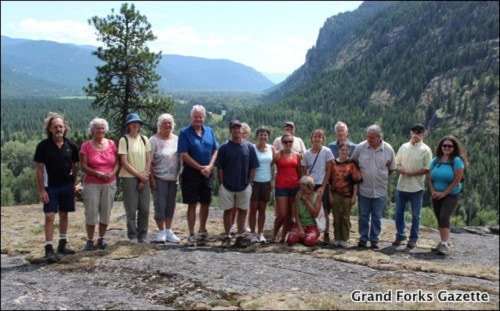A year has passed since the ad hoc environmental group Friends and Residents of the North Fork (FRNF) expressed concerns to the province regarding a Chinese company’s mining permit.
The permit sought by North America Stone Inc. (NAS) sought to remove 10,000 tons of granite from the granite bluffs 25 km up North Fork Road. Since that time, the group’s concerns have increased.
The environmental impact of the mining operation, already a concern of the FRNF, grew after North Fork resident Dana Riester found one endangered plant species in the area. “There are four red-listed species noted to be in the area, and since I had spotted one, the Ministry of Energy, Mines and Natural Gas (MEMNG) consented to have biologist Lisa Tedesco come to the area to take a sample. She also found another red-listed plant, hair bell. The samples were sent to Victoria and confirmed as the red-listed species,” she said.
“Since two red-listed plants are now confirmed, (MEMNG) has required NAS to submit a more thorough environmental assessment.”
Riester hopes that the presence of the plants will result in the ministry requiring a more thorough environmental assessment. She is worried however, because the company NAS hired to look for red-listed plants (Summit Environmental Consultants) reported there were no red-listed plants.
A further concern was raised by local resident Larry Butler over the way in which the company had applied to remove the 4x4x8-foot blocks of granite.
In the original permit application, NAS had proposed to use a D7 Cat to drag the blocks along its 425-metre exploration trail to its access road and then load them on a low bed trailer.
The ministry, however, required the company to alter those plans and load the blocks directly onto a piece of wheeled equipment.
According to Butler, the road required to accommodate such an operation would require much more ground disturbance than the company had applied for in its permit. Former forest service employee Bob Keep agrees. Keep was for a number of years responsible for the maintenance and construction of forest service roads in the Boundary/Kootenay area.
“Solid granite weighs 168 pounds per cubic foot,” Keep said. “The proposed blocks would weigh 10 tons. A very large piece of equipment will be needed to transport these blocks to the truck loading site. This means that the proposed exploration trail will have to beat least 12 feet wide or about the width of most logging roads.” This, said Keep, is of particular concern because the trail is adjacent to a stream bed with several stream crossings. “About half the distance is over very steep, rocky terrain,” he added.
The FRNF notes that in the original permit application, the company had indicated that there would be no stream crossings and that work would not occur in or around water.
“In the summer, the creek sometimes dries up,” Butler said. “Most of the time it isn’t dry. I was up there Thursday (Jan. 3) and it was flowing even then.”
“(MLA) John Slater, (NDP environmental critic) Rob Fleming and (NDP candidate) Marji Basso have all been up there to look at the bluffs and see what a shame it would be to destroy them,” Riester said. “Though with the mining policies and rules the way they are, I don’t know. We’re hopeful.”
Neither NAS or Glen Hendrickson, a senior permitting inspector for the ministry, responded for comment as of press time.
